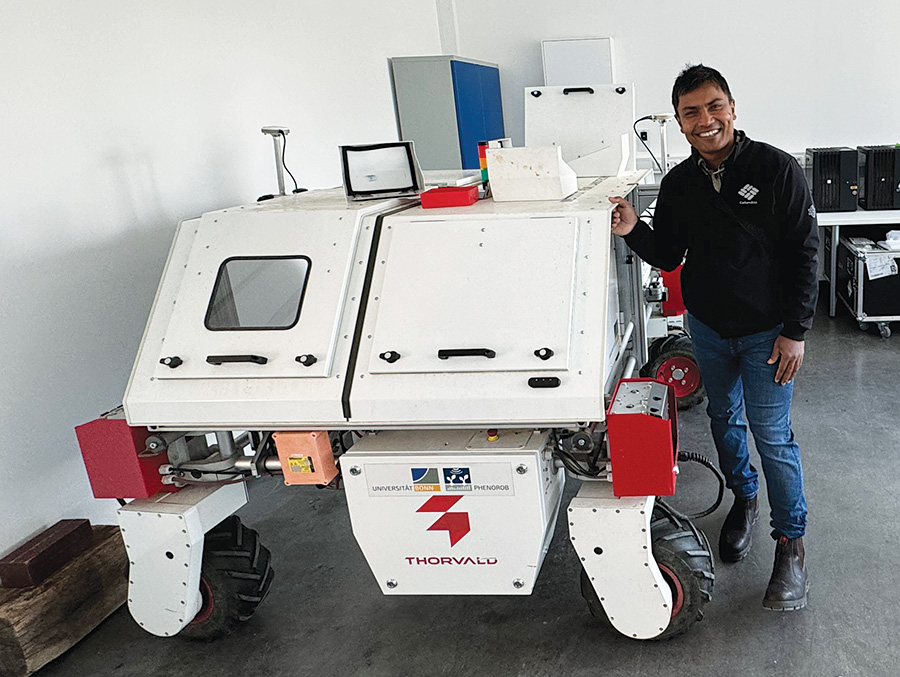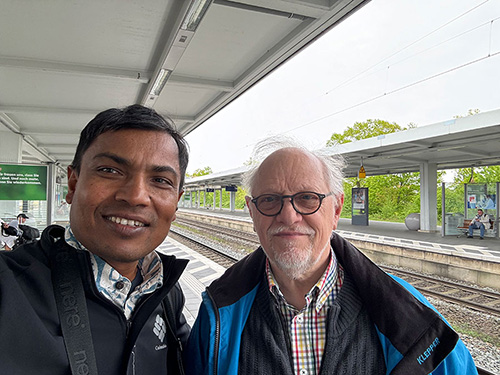Key points
- Significant gains in yield and water use efficiency have been achieved for canola, wheat, barley and triticale through an innovative GRDC-supported soil re-engineering project
- For Dr Gaus Azam, these achievements are just the beginning
- Following a recent trip to Germany, he is looking to identify scalable machinery for growers to use, inspired by the advanced prototypes he observed
- Dr Azam also plans to visit the US and Canada to explore soil research and agronomic management packages for high-yielding crops
To ensure the productivity gains made from re-engineered soil experiments in Western Australia are readily available to all growers, Dr Gaus Azam is on a worldwide mission.
His GRDC-supported experiments have led to significant increases in grain yields and water use efficiency (WUE) on sand and texture-contrast soils.
For example, yield gains of up to 2.2 tonnes per hectare for canola, 2.7t/ha for wheat and 2.7t/ha for barley were achieved compared with the paddock controls. At selected sites, this establishes new rainfall-limited yield potentials.
WUE also increased by up to 18.7, 16.5, 15.1 and 10.0 kilograms of grain per millimetre for canola, wheat, barley and triticale, respectively.
Now Dr Azam is seeking ways this work can be done without the earthmoving equipment and physical labour he and his team used. With GRDC support via a Recognising and Rewarding Excellence Award, he has travelled to Germany and has further travel planned for the US and Canada.
Dr Azam says with the Germans highly regarded as machinery developers, he was keen to visit. “I wanted to see what equipment they were developing to better farm their soils and what could be transferrable to our situations.”
Based at Northam, Dr Azam is a principal soil scientist with the Department of Primary Industries and Regional Development.
He leads the GRDC-supported ‘Re-engineering Soils’ project. It involves laboratory, glasshouse and field-based experiments to address multiple interacting soil constraints in the crop root zone. His team has been combining innovative soil amelioration techniques and soil profile re-engineering to test the limits of crop production.
“We farm a hostile and ancient landscape in Australia very effectively, but I think there is still room to improve if we are open to new solutions and work collaboratively.”

Dr Gaus Azam with a robot designed for precision herbicide spray at the University of Bonn’s Institut fur Landtechnik. Photo: courtesy Gaus Azam
A postcard from Germany
During his two weeks in Germany, Dr Azam visited the University of Bonn’s Landtechnik and Soil Science Groups, including research at the Klein-Altendorf campus and a 900ha research farm at Burg Gladbach, bequeathed to the university and other institutes in the region.
Dr Azam says differences between Australia and Germany include the following.
- Research: “The Germans use scientific hypotheses for their experiments that are well thought out. They pay great attention to detail when designing equipment and research trials to achieve their aims. They also focus on predicting future grain production challenges. For example,
I visited a long-term lime trial that was not acidic at the beginning, and it now appears that the unlimed plots are becoming acidic after years of observation. The scientists have been fortunate to have been able to collect data for years without interruption to monitor and establish trends.” - Soil type: “Soils in this area of Germany are loamy with high organic matter and high buffering capacity. They are more fertile and less susceptible to acidification and compaction than Australian soils.”
- Farm size: “Paddock sizes in western Germany are six to 7ha with a maximum of about 30ha.”
- Machinery: German machinery is much smaller than Australian machinery, commonly operating on three, six or nine-metre widths and lower horsepower, commonly 250.
- Practices: “Soil is cultivated two or three times a year, commonly with mouldboard ploughs and with much lower amounts of herbicide applied than in Australia.”
- Crops: Crops produced are much more diverse than in Australia and include peas and faba beans as well as root crops, sugar beets, potatoes and carrots for pharmaceutical use, as well as cereals.
- Yield: Cereals grow over a nine to 10-month period. With no shortage of water, yields are up to 12t/ha. German growers apply up to 300kg/ha of nitrogen to achieve this. Some growers also recycle nutrients through stubble retention.
“Discussing concerns around such large crop yields led me to consider the implications for crop lodging in the Australian soils that we are re-engineering, especially where a high rate of organic matter is applied and the scope for exploring plant growth regulators.” - Learnings: The German team is developing prototype machinery for soil re-engineering and sensors for soil measurements.
For Australia, the most relevant and potentially scalable prototype is a subsoiler, created by Dr Oliver Schmittmann and his team. This subsoil machine trails a mouldboard plough, deep ripper, composter and grader. This set-up allows the topsoil (0 to 30cm – much deeper than is the case in WA) to be maintained at the top without mixing with the hostile subsoil while loosening and injecting soil amendments into the subsoil.
“I’m excited to explore what possible collaborations we can devise going forward for the benefit of both countries now we have established connections in person.”
During his stay in Bonn, Dr Azam gave two seminars on his past and current research projects. These seminars were invaluable in helping German students consider postgraduate programs in Australia.
Mentor catch-up
Dr Azam also reconnected with an early career mentor, Dr Michael Zoebisch, while in Germany. Dr Zoebisch supervised Dr Azam’s master’s project at the Asian Institute of Technology in Thailand.
 Dr Gaus Azam with his mentor, Dr Micheal Zoebisch, in Braunschweig, Germany. Dr Zoebisch supervised Dr Azam’s master’s project at the Asian Institute of Technology in Thailand. Photo: courtesy Gaus Azam
Dr Gaus Azam with his mentor, Dr Micheal Zoebisch, in Braunschweig, Germany. Dr Zoebisch supervised Dr Azam’s master’s project at the Asian Institute of Technology in Thailand. Photo: courtesy Gaus Azam
“Dr Zoebisch was an inspirational teacher and innovative thinker,” Dr Azam says. “We had the opportunity to share memories and for me to refresh methods of measuring soil attributes. For example, we discussed how various attributes interact together to act as a soil quality index. He reminded me of the importance of measuring soil carbon, particle size distribution, soil structure and aggregate crushing strength and stability. These soil parameters, as a unit, determine how rainwater enters, moves through the soil, and is stored and made available for plants to grow and produce grains.”
Dr Azam plans to present his learnings to peers back in Australia before embarking on the second phase of his travels to the US and Canada.
“Researchers in these countries are data leaders, together with agronomic and breeding experts. I’m looking forward to learning about developments in soil research and agronomic packages to support re-engineered soils.”
More information: Gaus Azam, gaus.azam@dpird.wa.gov.au

























































